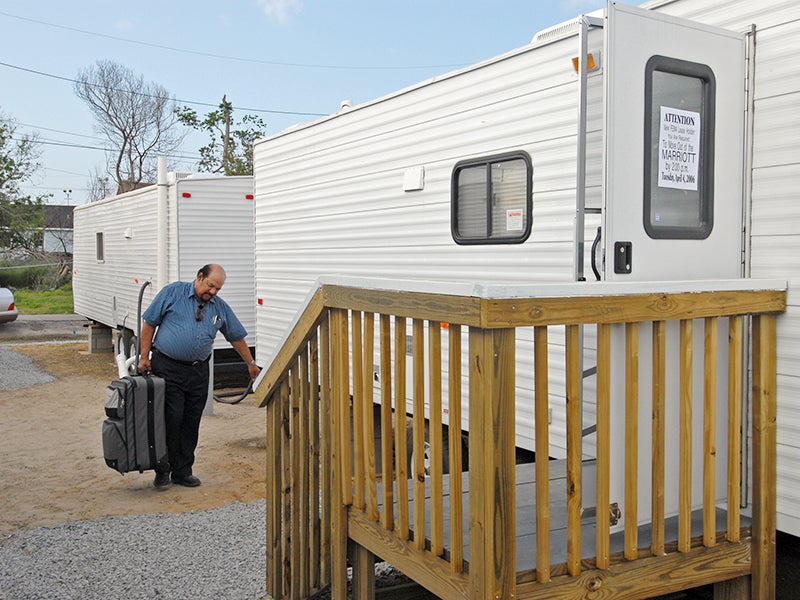Judge Requires EPA to Enforce Formaldehyde Restrictions in Wood Products
Victory
—Agency must expeditiously implement emissions standards
Contact
Today, a federal judge has ruled that the U.S. Environmental Protection Agency (EPA) illegally delayed a rule intended to protect public health from formaldehyde.
As mandated by Congress, EPA set limits on the amounts of hazardous formaldehyde gas that can be released from various types of manufactured wood products made and sold in the United States, including materials used in cabinets, flooring and furniture and in emergency housing and travel trailers. Formaldehyde is a carcinogen that also causes and exacerbates respiratory ailments.
Under the rule finalized in 2016, wood products had to comply with the limits in December 2017. The Trump administration extended the compliance deadline to December 2018.
The New Orleans-based group A Community Voice and the Sierra Club, represented by Earthjustice, filed a lawsuit challenging the delay. The case was filed October 31, 2017, in U.S. District Court in Oakland, California.
In today’s ruling, Judge Jeffrey White found “the Delay Rule is beyond the scope of the EPA’s authority and is not in accordance with the Formaldehyde Act,” which required the formaldehyde limits. The delay “fails to satisfy the stated purpose of the Act,” which he described as “the expeditious implementation of emission standards designed to protect both the public health of vulnerable populations” and domestic manufacturers who are, in large part, meeting the formaldehyde limits from imported goods that are not.
The decision is especially good news for the many Gulf Coast residents who, in the aftermath of Hurricanes Katrina and Rita, were provided emergency shelter by the U.S. Department of Homeland Security Federal Emergency Management Agency (FEMA) in mobile homes and travel trailers that ended up causing serious health problems added to the dislocation from the storms.
“There is no simple, ‘long-term fix’ for the side effects of formaldehyde poisoning, since the poisoning begins immediately,” said A Community Voice Vice President Vanessa Gueringer. “So, the Formaldehyde Emissions Standards must be put in place immediately. We have waited far too long.”
The Sierra Club has been an advocate for these standards for a decade, in dialogue with such groups as the Composite Panel Association and the nonprofit National Center for Healthy Housing to make California’s tough, state formaldehyde standards the federal requirement.
“Today’s long-overdue decision is an important step in ensuring the health and safety of Americans recovering from disasters,” said Leslie Fields, director of the Sierra Club’s Environmental Justice and Community Partnerships Program. “The EPA’s own mission is to protect Americans from significant risks to human health, and these formaldehyde standards do just that. It’s time for EPA to do its job.”
“At long last, the EPA will protect people from hazardous formaldehyde in everyday furnishings and building materials,” Earthjustice Attorney Patti Goldman added. “The Court enforced the law and put an end to EPA’s moves to delay complying with the deadline Congress set for banning formaldehyde emissions.”
The Court has directed the parties to confer about the timely implementation of the Court’s order and report to the Court by March 9, 2018.
Read the blog post: EPA Stalls on Regulating Chemical That Sickened Katrina Refugees
Formaldehyde: A Toxic Timeline
2005: Gulf Coast residents displaced by Hurricanes Katrina and Rita begin reporting serious health problems linked to high formaldehyde emissions in travel trailers provided for emergency housing by FEMA.
2006: Indoor air quality tests by the Sierra Club of 31 of these dwellings in Mississippi and Louisiana find excessive formaldehyde levels in 96 percent of them.
2007: FEMA works with the Centers for Disease Control, which finds unsafe levels of formaldehyde in one-third of the FEMA trailers tested. FEMA adopts “Interim Direction on Use of Temporary Housing Units,” requiring that people who complain about formaldehyde-related problems be given other housing options rather than a replacement trailer.
2008: California adopts limits on formaldehyde emissions from wood products, to be phased in over the next several years.
2009: A report by the U.S. Office of the Inspector General details the problems getting FEMA to do its own tests and mitigate the complaints. Among the conclusions: “It is clear that the lack of a definitive, consistent, and well-promulgated FEMA policy resulted in some cases of problem trailers not being handled consistently.”
2010: Congress passes the Formaldehyde Emission Standards for Composite Wood Products Act of 2010, requiring the EPA to adopt California’s formaldehyde emission standards for wood products. Congress directs EPA to require compliance with these standards in 2013, along with provisions for testing, labeling and enforcement.
2016: In July, the EPA signs—and in December, it publishes—the new rule. The rule’s effective date is Feb. 10, 2017, with compliance required for most wood products by December 12, 2017.
2017: The EPA delays the rule’s effective date until May 22, 2017. In late September, EPA extends the compliance deadline for a full year, so that compliance will not be required until December 12, 2018.

Additional Resources
About Earthjustice
Earthjustice is the premier nonprofit environmental law organization. We wield the power of law and the strength of partnership to protect people's health, to preserve magnificent places and wildlife, to advance clean energy, and to combat climate change. We are here because the earth needs a good lawyer.